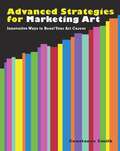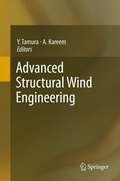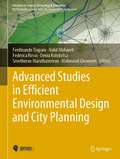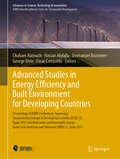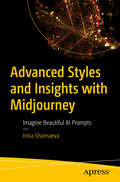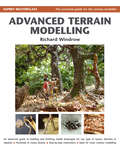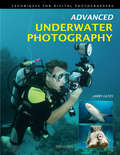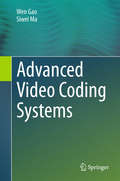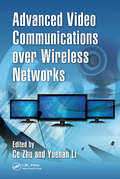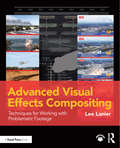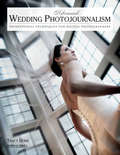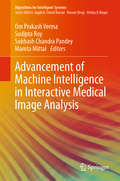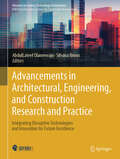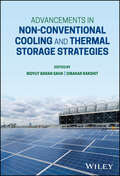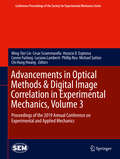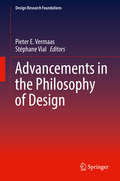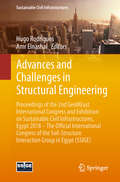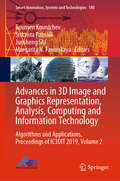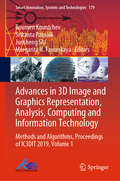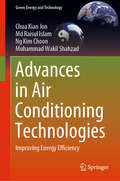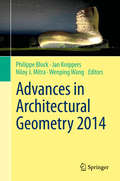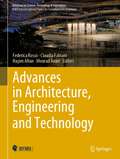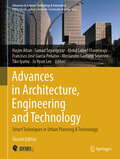- Table View
- List View
Advanced Strategies for Marketing Art
by Constance SmithEducating oneself in all aspects of marketing is a necessity for any emerging or established artist. In this new book, artists will be taught to think about innovative and genre-specific marketing venues that they otherwise never would have explored.Names and websites of prominent and established art world professionals in a variety of venues are noted. Advance tax issues that will help artists save money are addressed, as well as advertising venues and direct mail innovations. Exposing your artwork online is discussed in detail, including how to develop a profitable and respectful website. Detailed information on how to approach a gallery owner and how to find a rep is also included. Information on art retreats and workshops is covered.Several prominent art world professionals have added their two cents in a variety of articles throughout the chapters, giving direct insight into how art professionals think and work. If you are a working, professional, exhibiting artist, you can't pass up this book, which will take you to new levels in your career.
Advanced Structural Wind Engineering
by Yukio Tamura Ahsan KareemThis book serves as a textbook for advanced courses as it introduces state-of-the-art information and the latest research results on diverse problems in the structural wind engineering field. The topics include wind climates, design wind speed estimation, bluff body aerodynamics and applications, wind-induced building responses, wind, gust factor approach, wind loads on components and cladding, debris impacts, wind loading codes and standards, computational tools and computational fluid dynamics techniques, habitability to building vibrations, damping in buildings, and suppression of wind-induced vibrations. Graduate students and expert engineers will find the book especially interesting and relevant to their research and work.
Advanced Studies in Efficient Environmental Design and City Planning (Advances in Science, Technology & Innovation)
by Denia Kolokotsa Nabil Mohareb Mahmoud Ghoneem Ferdinando Trapani Federica Rosso Sreetheran MaruthaveeranThis book explains how learning from past mistakes in urban design can help to enhance sustainable cities and how the principles of Green Urbanism can yield more resilient urban settlements. Environmental design is a fundamental principle in shaping cities. However, environmental challenges like increased resource consumption, water degradation and waste-related issues are among the greatest problems now facing humanity – which is why these issues need to be considered with regard to “smart cities,” either for the development of new urban centers or for the transformation of existing cities. The book not only discusses the importance of integrating sustainability principles in the urban design process, but also demonstrates their application to the development of sustainable cities. As such, the book offers essential information and a source of inspiration for all those who want to build more sustainable cities.
Advanced Studies in Energy Efficiency and Built Environment for Developing Countries: Proceedings of IEREK Conferences: Improving Sustainability Concept in Developing Countries (ISCDC-2), Egypt 2017 and Alternative and Renewable Energy Quest in Architecture and Urbanism (AREQ-2), Spain 2017 (Advances in Science, Technology & Innovation)
by Chaham Alalouch Hassan Abdalla Emmanuel Bozonnet George Elvin Oscar CarracedoThis edited volume consists of three parts. It is a culmination of selected research papers presented at the second version of the international conference on Improving Sustainability Concept in Developing Countries (ISCDC) and the second version of the international conference on Alternative and Renewable Energy Quest in Architecture and Urbanism (AREQ), organized by IEREK in Egypt, 2017. It discusses major environmental issues and challenges which threaten our future. These include climate change impact, environmental deterioration, increasing demand for energy and new approaches for alternative renewable energy sources which became a necessity for survival. In addition to addressing the different environmental issues witnessed today, research presented in this book stressed on the need of sustainably shaping buildings and cities using renewable energy sources. Topics included in this book are (1) Resilience in the Built Environment, (2) Design for energy-efficient architecture and (3) Alternative and Renewable Energy Resources Quest in Architecture and Urbanism. The book is of interest to researchers and academicians who continuously aim to update their knowledge in these fields, as well as decision makers needing the enough knowledge to carry out the right decisions towards the benefit of the environment and society.
Advanced Styles and Insights with Midjourney: Imagine Beautiful AI Prompts
by Irina ShamaevaExplore advanced techniques in AI image generation with a focus on enhancing creativity and producing unique styles using the Midjourney platform, an AI image-generating (text-to-image) program unparalleled in the aesthetics of images it can produce. This book is for anyone ready to push their AI art further, with guidance straight from a seasoned AI artist and user of Midjourney. Unlike a basic tutorial, this book focuses on advanced prompt crafting strategies, understanding Midjourney's evolving algorithms, and harnessing these tools to produce art that resonates on personal and communal levels. Author Irina Shamaeva shares insights gained from creating and sharing art that has captivated over 8,000 followers on social media in a year. You’ll see how to think out of the box with AI art creation and gain practical tips and techniques for drawing. Expect practical tips on making the most of Midjourney for your art, insights from the author's experience, and stories from the AI art world. This book is not just about how to use Midjourney; it's about creating art that matters to you and others. Advanced Styles and Insights with Midjourney will allow you to channel your creativity with more sophisticated drawing techniques, concepts, and new complementary tools. What You Will Learn Combine the features of two recent Midjourney versions, getting the best qualities of each. Explore a "hidden" unofficial version of Midjourney that has a wild imagination. Use the Vary(Subtle), Vary(Strong), and Vary(Region) functions to manipulate your images. Work with multimedia - images along with text - as image prompts and style references. Who This Book Is For Graphic designers, architects, book illustrators, product photographers, game developers, fashion and interior designers, educators, AI researchers using text-to-image software, and any Midjourney user wanting to enhance their prompting skills.
Advanced Terrain Modelling
by Richard WindrowThe secrets of top-class terrain modelling are revealed and demonstrated by Richard Windrow, one of the world's leading diorama modellers, in this new addition to the successful Masterclass series. Everything from medieval castles to the destruction wrought upon modern cities by war is covered in this wide-ranging and accessible approach. Explore the difficulties of creating an effective desert environment from the sandstone of Arizona to the wastelands of North Africa. Discover the delicate handiwork needed to create the barbed wire death traps of No-Man's Land and the frozen wilderness of Russia in winter.This variety of seasons, environments and historical periods are detailed in over 200 full color step-by-step photographs so that a range of modeller's "how to" questions are easily answered. Accompanying the photographs is an invaluable guide to the materials and techniques needed to create top quality terrain, providing the essential reference volume for the military and non-military modeller alike.
Advanced Underwater Photography
by Larry GatesDesigned for photographers who already have strong diving skills and understand basic photographic techniques, this reference defines what advanced underwater photography is while teaching the skills necessary to create professional-quality images. Opening with a quick overview of the basics—such as exposure, focus, subject selection, and composition—the author then expands on each of these topics, showing the techniques pros use to achieve truly stunning images. A major factor in advancing beyond the basic level of underwater photography is moving from a point-and-shoot or semi-adjustable camera to using a full-featured digital SLR camera. The myriad equipment choices available when making this transition—including cameras, lenses, underwater housings, and the lighting units designed to be used with them—are explained, as are their respective advantages and shortcomings. Because both beginning and advanced underwater photographers can have equipment-related issues, a trouble-shooting section is included to ensure that minor equipment problems won’t ruin a costly dive trip.
Advanced Underwater Photography
by Larry GatesDesigned for photographers who already have strong diving skills and understand basic photographic techniques, this reference defines what advanced underwater photography is while teaching the skills necessary to create professional-quality images. Opening with a quick overview of the basics--such as exposure, focus, subject selection, and composition--the author then expands on each of these topics, showing the techniques pros use to achieve truly stunning images. A major factor in advancing beyond the basic level of underwater photography is moving from a point-and-shoot or semi-adjustable camera to using a full-featured digital SLR camera. The myriad equipment choices available when making this transition--including cameras, lenses, underwater housings, and the lighting units designed to be used with them--are explained, as are their respective advantages and shortcomings. Because both beginning and advanced underwater photographers can have equipment-related issues, a trouble-shooting section is included to ensure that minor equipment problems won't ruin a costly dive trip.
Advanced Video Coding Systems
by Wen Gao Siwei MaThis book presents an overview of the state of the art in video coding technology. Specifically, it introduces the tools of the AVS2 standard, describing how AVS2 can help to achieve a significant improvement in coding efficiency for future video networks and applications by incorporating smarter coding tools such as scene video coding. Features: introduces the basic concepts in video coding, and presents a short history of video coding technology and standards; reviews the coding framework, main coding tools, and syntax structure of AVS2; describes the key technologies used in the AVS2 standard, including prediction coding, transform coding, entropy coding, and loop-filters; examines efficient tools for scene video coding and surveillance video, and the details of a promising intelligent video coding system; discusses optimization technologies in video coding systems; provides a review of image, video, and 3D content quality assessment algorithms; surveys the hot research topics in video compression.
Advanced Video Communications over Wireless Networks
by Ce Zhu Yuenan LiWireless video communications encompass a broad range of issues and opportunities that serve as the catalyst for technical innovations. To disseminate the most recent advances in this challenging yet exciting field, Advanced Video Communications over Wireless Networks provides an in-depth look at the fundamentals, recent technical achievements, challenges, and emerging trends in mobile and wireless video communications. The editors have carefully selected a panel of researchers with expertise in diverse aspects of wireless video communication to cover a wide spectrum of topics, including the underlying theoretical fundamentals associated with wireless video communications, the transmission schemes tailored to mobile and wireless networks, quality metrics, the architectures of practical systems, as well as some novel directions. They address future directions, including Quality-of-Experience in wireless video communications, video communications over future networks, and 3D video communications. The book presents a collection of tutorials, surveys, and original contributions, providing an up-to-date, accessible reference for further development of research and applications in mobile and wireless video communication systems. The range of coverage and depth of expertise make this book the go-to resource for facing current and future challenges in this field.
Advanced Visual Effects Compositing: Techniques for Working with Problematic Footage
by Lee LanierIn Advanced Visual Effects Compositing: Techniques for Working with Problematic Footage, learn to tackle difficult visual effect composites in layer-based and node-based compositing programs. In this book, industry veteran and compositing expert Lee Lanier offers tips, tricks, techniques, and workflows for difficult visual effects shots, including poorly shot green screen, moving shots with no visible motion tracking marks, shots requiring three-dimensional (3D) elements that lack 3D renders, poor-quality stock footage, and incorrectly lit shots. Lanier details the common problems of visual effects shots and offers practical solutions using examples from Adobe After Effects and Blackmagic Design Fusion. An accompanying eResource (www.routledge.com/9781138668348) features video image sequences, 3D renders, and other tutorial materials, allowing you to practice the discussed techniques. The visual effects challenges covered in this book include: Chroma keying Motion tracking Relighting in the composite Repairing plates Replicating damage Adding depth with 2.5D Working with stock footage
Advanced Wedding Photojournalism: Professional Techniques for Digital Photographers
by Tracy DorrAiming to produce more vibrant, emotional, and compelling images, this guide instructs how to instinctively capture the most important moments at a wedding. By emphasizing a deeper understanding of the client and the importance of practicing technical skills, this in-depth reference explores the roles of preparation and patience in capturing memorable photographs. Since being in the right place at the right time is imperative, instruction is also provided on how to evaluate body language and subtle clues during the event. In addition, this manual, designed specifically for the professional wedding photographer, demonstrates how postproduction, album design, and photographer#150;client communication can maximize sales and customer satisfaction.
Advancement of Machine Intelligence in Interactive Medical Image Analysis (Algorithms for Intelligent Systems)
by Mamta Mittal Om Prakash Verma Sudipta Roy Subhash Chandra PandeyThe book discusses major technical advances and research findings in the field of machine intelligence in medical image analysis. It examines the latest technologies and that have been implemented in clinical practice, such as computational intelligence in computer-aided diagnosis, biological image analysis, and computer-aided surgery and therapy. This book provides insights into the basic science involved in processing, analysing, and utilising all aspects of advanced computational intelligence in medical decision-making based on medical imaging.
Advancements in Architectural, Engineering, and Construction Research and Practice: Integrating Disruptive Technologies and Innovation for Future Excellence (Advances in Science, Technology & Innovation)
by AbdulLateef Olanrewaju Silvana BrunoThis book offers a captivating discussion into the cutting-edge developments at the intersection of architecture, engineering, construction, and technology. With a focus on the power of big data analytics and computational design, this book delves into the transformative potential of these domains in shaping the built environment and business. This book discovers the fusion of architectural and engineering innovations with the capabilities of big data analytics, machine learning, and AI and explores how this parallelism is revolutionizing the design process, enhancing efficiency, and opening new horizons for creativity. This book steps into a world where predictive models, statistical algorithms, and what-if scenarios drive advancements in architectural and engineering practices and witnesses the seamless integration of technology in design generation, data visualization, task automation, and performance testing. It is an essential read for researchers and professionals seeking to leverage the potential of big data analytics to transform the built environment, maintaining the central role of humans.
Advancements in Nanotechnology for Energy and Environment (Advances in Sustainability Science and Technology)
by Dharmendra Tripathi Ravi Kumar Sharma Hakan F. ÖztopThis book presents a very useful and valuable collection of chapters associated with recent developments in energy, environment, and nanotechnology including nanofluids dynamics. The book provides insights related to various forms of nanotechnological applications in green buildings, environmental and electrochemical systems, solar distillation systems, green energy, storage tank of the solar water heating systems, solar concentrator system's receiver, solar adsorption refrigeration system, and CFD simulations of various aspects of nanofluids/hybrid nanofluids, which are particularly useful, valuable for the betterment of society, culture, and ultimately mankind.
Advancements in Non-Conventional Cooling and Thermal Storage Strategies
by Bidyut Baran Saha Dibakar RakshitAn exploration of the technical, economic, and energy-saving aspects of the design, modeling, and operation of non-conventional cooling and heating systems Cooling and heating can collectively constitute one of the largest sources of energy consumption in a modern building, with attendant costs and sustainability concerns. As the global climate changes and temperature extremes produce demand for even greater energy consumption, energy-efficient methods for cooling interior spaces have become more important than ever. Our sustainable future demands non-conventional methods for cooling and thermal storage which can meet the demands of a changing climate and an efficient, renewable power grid. Advancements in Non-Conventional Cooling and Thermal Storage Strategies offers a detailed introduction to the latest cutting-edge space conditioning technologies for buildings. Beginning with an overview of activated carbon-based adsorbents and their potential heating and cooling applications, it moves to an analysis of Phase Change Materials (PCMs) as a potential sustainable cooling source. Thorough, rigorous, and fully up to date, it’s indispensable for a range of professionals working to make habitable, energy-efficient human spaces. Advancements in Non-Conventional Cooling and Thermal Storage Strategies readers will find: Techniques for both active and passive space conditioning systemsDetailed discussion of topics including adsorbent-refrigerant pairings, techniques for incorporating fresh air at high air change per hour, and moreA composite case study with examples from across the globe to provide an understanding of technical requirements Advancements in Non-Conventional Cooling and Thermal Storage Strategies is ideal for researchers and professional mechanical and civil engineers, those working in space-cooling, HVAC, and building design industries, and research and design personnel of HVAC equipment manufacturing industry.
Advancements in Optical Methods & Digital Image Correlation in Experimental Mechanics, Volume 3: Proceedings of the 2019 Annual Conference on Experimental and Applied Mechanics (Conference Proceedings of the Society for Experimental Mechanics Series)
by Cosme Furlong Cesar Sciammarella Michael Sutton Horacio D. Espinosa Luciano Lamberti Ming-Tzer Lin Phillip Reu Chi-Hung HwangAdvancement of Optical Methods & Digital Image Correlation in Experimental Mechanics, Volume 3 of the Proceedings of the 2019 SEM Annual Conference & Exposition on Experimental and Applied Mechanics, the third volume of six from the Conference, brings together contributions to this important area of research and engineering. The collection presents early findings and case studies on a wide range of optical methods ranging from traditional photoelasticity and interferometry to more recent DIC and DVC techniques, and includes papers in the following general technical research areas: DIC Methods & Its ApplicationsPhotoelsticity and Interferometry ApplicationsMicro-Optics and Microscopic SystemsMultiscale and New Developments in Optical MethodsDIC and its Applications for Inverse Problems
Advancements in the Philosophy of Design (Design Research Foundations Series)
by Pieter E. Vermaas Stéphane VialThis volume presents 25 essays on the philosophy of design. With contributions originating from philosophy and design research, and from product design to architecture, it gives a rich spectrum of state of the art research and brings together studies on philosophical topics in which design plays a key role and design research to which philosophy contributes. Coverage zooms in on specific and more well-known design disciplines but also includes less-studied disciplines, such as graphic design, interior architecture and exhibition design. <P><P>In addition, contributors take up traditional philosophical issues, such as epistemology, politics, phenomenology and philosophy of science. Some essays cover philosophical issues that emerge in design, for instance what design can do in addressing societal problems, while other essays analyze main-stream philosophical issues in which design is part of the argument, as for instance abduction and aesthetics. Readers will discover new research with insightful analyses of design research, design thinking and the specificity of design. Overall, this comprehensive overview of an emerging topic in philosophy will be of great interest to researchers and students.
Advances and Challenges in Structural Engineering: Proceedings of the 2nd GeoMEast International Congress and Exhibition on Sustainable Civil Infrastructures, Egypt 2018 – The Official International Congress of the Soil-Structure Interaction Group in Egypt (SSIGE) (Sustainable Civil Infrastructures)
by Hugo Rodrigues Amr ElnashaiThis edited volume on challenges in structural and bridge engineering brings together contributions to this important area of engineering research. The volume presents findings and case studies on fundamental and applied aspects of structural engineering, applied to buildings, bridges and infrastructures in general, and heritage patrimony. The scope of the volume focuses on the application of advanced experimental and numerical techniques and new technologies to the built environment. The volume is based on the best contributions to the 2nd GeoMEast International Congress and Exhibition on Sustainable Civil Infrastructures, Egypt 2018 – The official international congress of the Soil-Structure Interaction Group in Egypt (SSIGE).
Advances in 3D Image and Graphics Representation, Analysis, Computing and Information Technology: Algorithms and Applications, Proceedings of IC3DIT 2019, Volume 2 (Smart Innovation, Systems and Technologies #180)
by Srikanta Patnaik Roumen Kountchev Margarita N. Favorskaya Junsheng ShiThis book gathers selected papers presented at the conference “Advances in 3D Image and Graphics Representation, Analysis, Computing and Information Technology,” one of the first initiatives devoted to the problems of 3D imaging in all contemporary scientific and application areas. The aim of the conference was to establish a platform for experts to combine their efforts and share their ideas in the related areas in order to promote and accelerate future development. This second volume discusses algorithms and applications, focusing mainly on the following topics: 3D printing technologies; naked, dynamic and auxiliary 3D displays; VR/AR/MR devices; VR camera technologies; microprocessors for 3D data processing; advanced 3D computing systems; 3D data-storage technologies; 3D data networks and technologies; 3D data intelligent processing; 3D data cryptography and security; 3D visual quality estimation and measurement; and 3D decision support and information systems.
Advances in 3D Image and Graphics Representation, Analysis, Computing and Information Technology: Methods and Algorithms, Proceedings of IC3DIT 2019, Volume 1 (Smart Innovation, Systems and Technologies #179)
by Srikanta Patnaik Roumen Kountchev Margarita N. Favorskaya Junsheng ShiThis book gathers selected papers presented at the conference “Advances in 3D Image and Graphics Representation, Analysis, Computing and Information Technology,” one of the first initiatives devoted to the problems of 3D imaging in all contemporary scientific and application areas. The aim of the conference was to establish a platform for experts to combine their efforts and share their ideas in the related areas in order to promote and accelerate future development. This second volume discusses algorithms and applications, focusing mainly on the following topics: 3D printing technologies; naked, dynamic and auxiliary 3D displays; VR/AR/MR devices; VR camera technologies; microprocessors for 3D data processing; advanced 3D computing systems; 3D data-storage technologies; 3D data networks and technologies; 3D data intelligent processing; 3D data cryptography and security; 3D visual quality estimation and measurement; and 3D decision support and information systems.
Advances in Air Conditioning Technologies: Improving Energy Efficiency (Green Energy and Technology)
by Chua Kian Jon Md Raisul Islam Ng Kim Choon Muhammad Wakil ShahzadThis book highlights key recent developments in air conditioning technologies for cooling and dehumidification with the specific objectives to improve energy efficiency and to minimize environmental impact. Today, air conditioning, comprising cooling and dehumidification, is a necessity in commercial and residential buildings and even in many industrial processes. This book provides key update on recent developments in air conditioning systems, cooling cycles and innovative cooling/dehumidification technologies. Key technologies related to cooling include heat-driven absorption and adsorption cooling and water-based dew point evaporative cooling. Technologies connected with dehumidification involve new generations of adsorbent–desiccant dehumidifiers, liquid-based desiccants and membranes that sieve out water vapor from air. Losses in cooling cycles and thermo-economic analysis for a sustainable economy are also judiciously documented.
Advances in Architectural Geometry 2014
by Philippe Block Jan Knippers Niloy J. Mitra Wenping WangThis book contains 24 technical papers presented at the fourth edition of the Advances in Architectural Geometry conference, AAG 2014, held in London, England, September 2014. It offers engineers, mathematicians, designers, and contractors insight into the efficient design, analysis, and manufacture of complex shapes, which will help open up new horizons for architecture. The book examines geometric aspects involved in architectural design, ranging from initial conception to final fabrication. It focuses on four key topics: applied geometry, architecture, computational design, and also practice in the form of case studies. In addition, the book also features algorithms, proposed implementation, experimental results, and illustrations. Overall, the book presents both theoretical and practical work linked to new geometrical developments in architecture. It gathers the diverse components of the contemporary architectural tendencies that push the building envelope towards free form in order to respond to multiple current design challenges. With its introduction of novel computational algorithms and tools, this book will prove an ideal resource to both newcomers to the field as well as advanced practitioners.
Advances in Architecture, Engineering and Technology (Advances in Science, Technology & Innovation)
by Haşim Altan Federica Rosso Claudia Fabiani Mourad AmerThis book examines a range of subjects with a specific focus on architectural and technological advancements. Architecture is the constant innovation in designing for high efficiency in the performance of buildings, in terms of planning, construction and energy, while maintaining creativity in its form. Moreover, the field of architecture goes hand in hand with that of technology. Nowadays, engineering technology has to cope with the rapid industrialization and urbanization seen in most countries. Furthermore, creative design and construction practices are challenging tasks to the architects and engineers to meet the ever-growing demands of society. Therefore, this book on "Advances in Engineering Science and Architectural Design" is provided to cover a wide range of topics in architecture, engineering, and technology.
Advances in Architecture, Engineering and Technology: Smart Techniques in Urban Planning & Technology (Advances in Science, Technology & Innovation)
by Abdul Lateef Olanrewaju Haşim Altan Ju Hyun Lee Tiko Iyamu Samad Sepasgozar Francisco José García Peñalvo Alessandro Gaetano SeverinoThis book summarizes the latest studies regarding innovation in urban design and planning. It shares many tips and insights about sustainable solutions for the issues facing transport systems, innovative digital technologies, and ICT trends. The book touches upon the need to integrate the three fields of Architecture, Engineering, and Technology that have become indispensable. This is intended to respond to the increasing human needs and population growth in cities on one hand and to develop a holistic approach that helps overcome challenges to sustainability and environment management on the other hand. With the power of engineering in practice, problems of design and development once considered too complex to be dealt with other than empirically, intuitively, or by trial and error, are now becoming more solvable and applicable. This book offers strategies and solutions that enable designers to bring together knowledge in the fields of architecture, engineering, and technology to overcome challenges facing in modern times.
